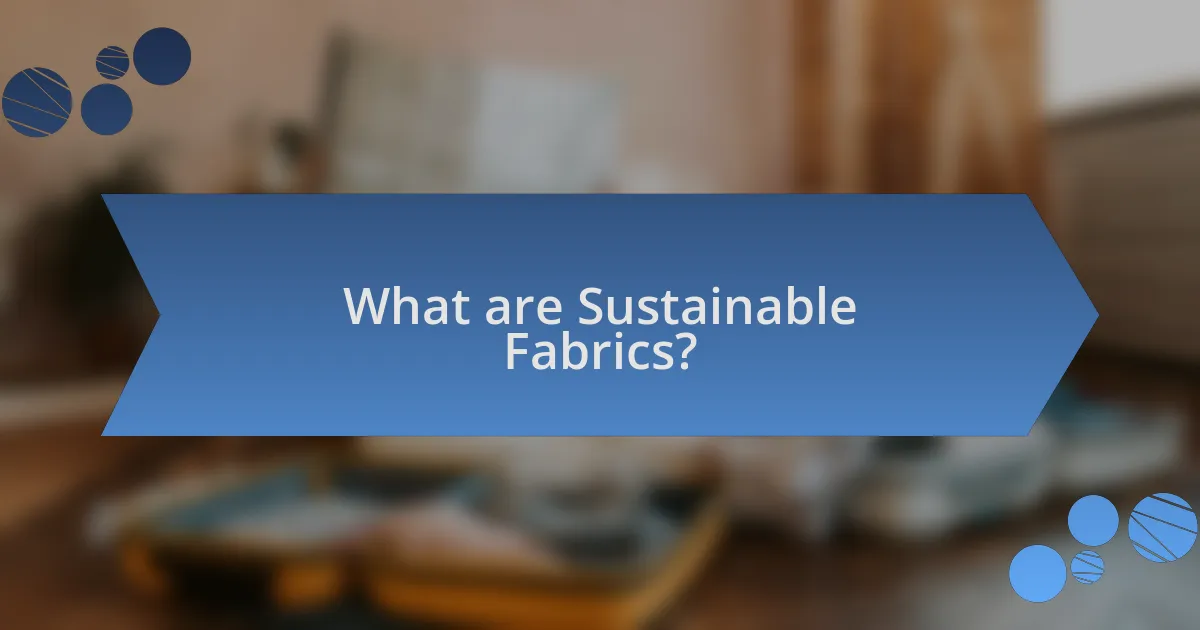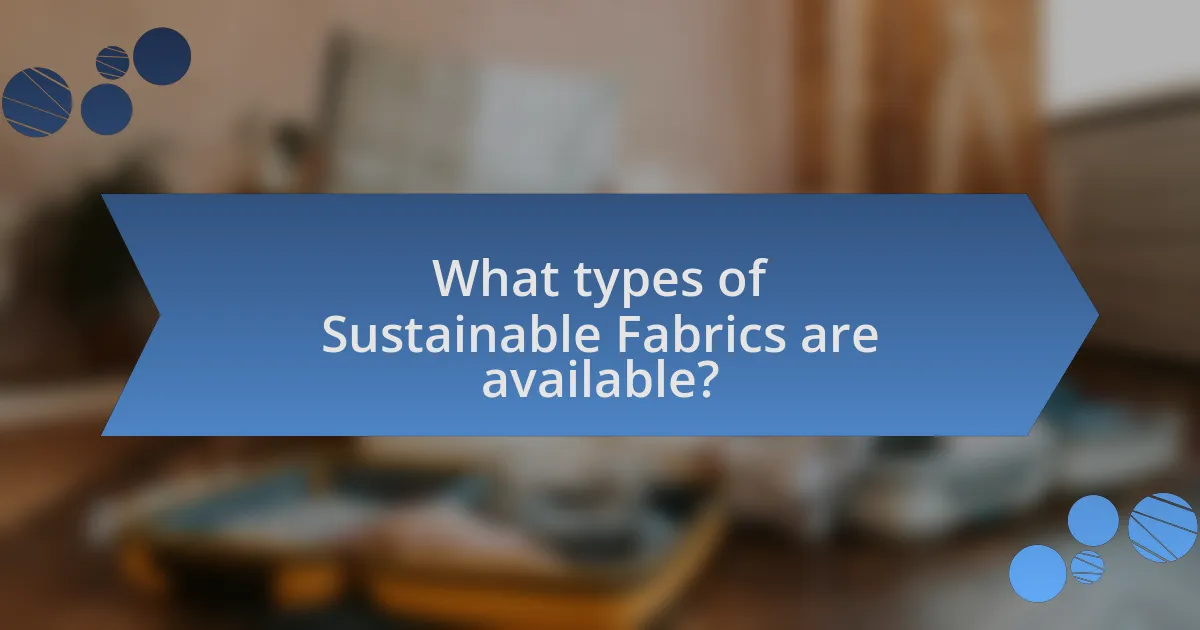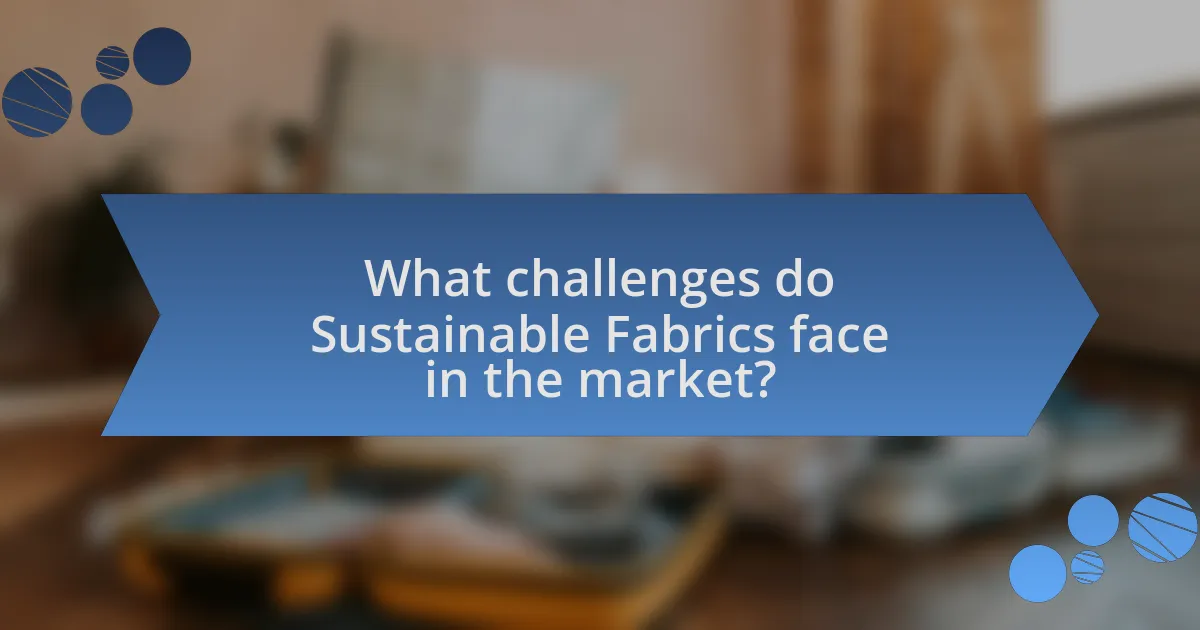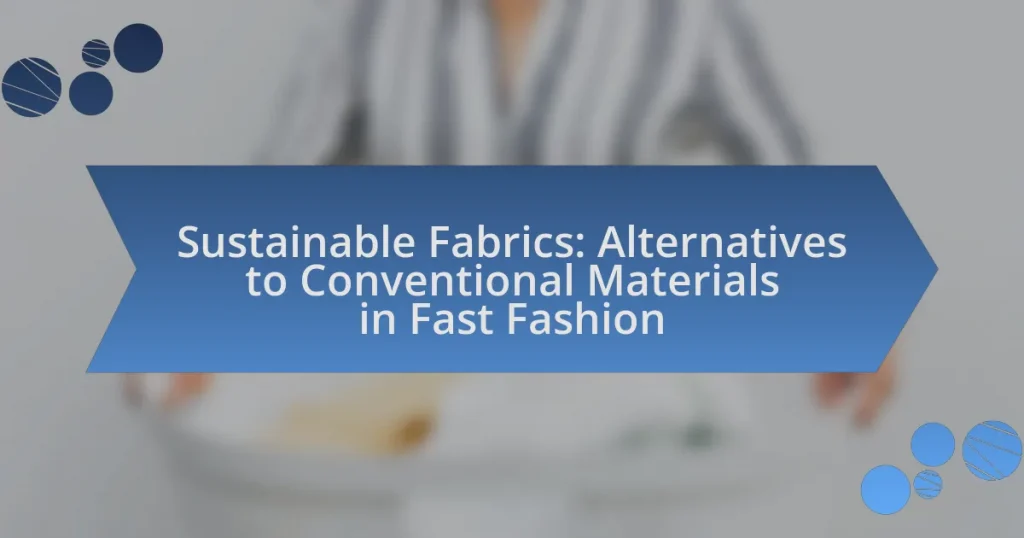Sustainable fabrics are eco-friendly materials produced with minimal environmental impact, utilizing renewable resources and ethical manufacturing processes. This article explores the differences between sustainable fabrics and conventional materials, highlighting their benefits in reducing water usage, pollution, and waste. It discusses the environmental challenges posed by fast fashion and the importance of transitioning to sustainable alternatives, such as organic cotton, hemp, Tencel, and recycled polyester. Additionally, the article addresses the barriers to adopting sustainable fabrics, misconceptions about their cost and durability, and practical steps consumers can take to support sustainable practices in the fashion industry.

What are Sustainable Fabrics?
Sustainable fabrics are materials produced with minimal environmental impact, often utilizing renewable resources and eco-friendly manufacturing processes. These fabrics include organic cotton, hemp, Tencel, and recycled polyester, which reduce water usage, chemical pollution, and waste compared to conventional textiles. For instance, organic cotton is grown without synthetic pesticides and fertilizers, significantly lowering its ecological footprint. Additionally, Tencel, made from sustainably sourced wood pulp, is produced in a closed-loop process that recycles water and solvents, further demonstrating the benefits of sustainable fabric production.
How do Sustainable Fabrics differ from Conventional Materials?
Sustainable fabrics differ from conventional materials primarily in their environmental impact and production processes. Sustainable fabrics are made from renewable resources, such as organic cotton or recycled polyester, which minimize resource depletion and reduce waste. In contrast, conventional materials often rely on non-renewable resources, like petroleum-based fibers, and involve harmful chemical processes that contribute to pollution. For example, the production of conventional cotton uses approximately 16% of the world’s insecticides and 7% of its pesticides, while organic cotton farming avoids these chemicals, promoting biodiversity and soil health. Thus, sustainable fabrics not only aim to reduce ecological harm but also support ethical labor practices, contrasting sharply with the often exploitative conditions found in conventional textile manufacturing.
What environmental impacts are associated with Conventional Materials?
Conventional materials, such as cotton, polyester, and leather, have significant environmental impacts including high water consumption, pollution, and greenhouse gas emissions. For instance, cotton farming requires approximately 7,000 liters of water to produce just one kilogram of cotton, leading to water scarcity in many regions. Additionally, the production of polyester, derived from petroleum, contributes to fossil fuel depletion and emits around 3.5 kg of CO2 for every kilogram produced. Furthermore, the tanning process for leather generates toxic waste, contaminating water sources and harming ecosystems. These factors collectively highlight the detrimental effects of conventional materials on the environment.
How do Sustainable Fabrics mitigate these impacts?
Sustainable fabrics mitigate environmental impacts by utilizing eco-friendly materials and production processes that reduce waste and pollution. For instance, organic cotton uses 91% less water than conventional cotton and avoids harmful pesticides, leading to healthier ecosystems. Additionally, fabrics made from recycled materials, such as polyester derived from plastic bottles, divert waste from landfills and decrease the demand for virgin resources. The use of low-impact dyes and non-toxic finishes further minimizes chemical runoff into waterways, protecting aquatic life. These practices collectively contribute to a more sustainable textile industry, addressing the significant environmental challenges posed by conventional fabric production.
Why is the shift to Sustainable Fabrics important in Fast Fashion?
The shift to sustainable fabrics is important in fast fashion because it significantly reduces environmental impact and promotes ethical production practices. Fast fashion is notorious for its high resource consumption and waste generation; for instance, the industry contributes to 10% of global carbon emissions and is responsible for massive water pollution. By adopting sustainable fabrics, brands can lower their carbon footprint, conserve water, and minimize chemical usage. Research indicates that using organic cotton can reduce water usage by up to 91% compared to conventional cotton. Additionally, sustainable fabrics often involve fair labor practices, addressing social issues within the supply chain. Thus, the transition to sustainable materials is crucial for fostering a more responsible and eco-friendly fashion industry.
What role does Fast Fashion play in environmental degradation?
Fast fashion significantly contributes to environmental degradation by promoting unsustainable production practices and excessive waste generation. The fast fashion industry is responsible for approximately 10% of global carbon emissions, primarily due to the rapid manufacturing processes and the reliance on fossil fuels. Additionally, it leads to water pollution, as the dyeing and treatment of fabrics often release toxic chemicals into waterways, affecting ecosystems and human health. The production of fast fashion garments also consumes vast amounts of water; for instance, producing a single cotton t-shirt can require up to 2,700 liters of water. Furthermore, fast fashion encourages a culture of disposability, resulting in millions of tons of textile waste each year, with only a small percentage being recycled. This combination of high emissions, water usage, and waste generation underscores the detrimental impact of fast fashion on the environment.
How can Sustainable Fabrics contribute to a more ethical fashion industry?
Sustainable fabrics contribute to a more ethical fashion industry by reducing environmental impact and promoting fair labor practices. These materials, such as organic cotton, hemp, and recycled polyester, require fewer resources and generate less pollution compared to conventional fabrics. For instance, organic cotton uses 91% less water than traditional cotton farming, significantly lowering water scarcity issues. Additionally, sustainable fabric production often involves ethical labor practices, ensuring fair wages and safe working conditions for workers. According to the Global Organic Textile Standard, certified organic textiles must adhere to strict social and environmental criteria, reinforcing the commitment to ethical practices in the fashion industry.

What types of Sustainable Fabrics are available?
Sustainable fabrics include organic cotton, hemp, Tencel (lyocell), recycled polyester, and bamboo. Organic cotton is grown without synthetic pesticides or fertilizers, reducing environmental impact. Hemp requires minimal water and no pesticides, making it a highly sustainable option. Tencel, produced from sustainably sourced wood pulp, is biodegradable and uses a closed-loop production process that recycles water and solvents. Recycled polyester is made from post-consumer plastic bottles, diverting waste from landfills and reducing reliance on virgin materials. Bamboo grows rapidly and requires little water, but its sustainability can vary based on processing methods. These fabrics collectively offer eco-friendly alternatives to conventional materials in the fashion industry.
What are the most common types of Sustainable Fabrics?
The most common types of sustainable fabrics include organic cotton, hemp, Tencel (lyocell), and recycled polyester. Organic cotton is grown without synthetic pesticides or fertilizers, reducing environmental impact. Hemp is a fast-growing plant that requires minimal water and no pesticides, making it highly sustainable. Tencel, derived from sustainably sourced wood pulp, is produced in a closed-loop process that recycles water and solvents. Recycled polyester is made from post-consumer plastic bottles, diverting waste from landfills and reducing the need for virgin materials. These fabrics are increasingly favored in the fashion industry for their lower ecological footprint compared to conventional materials.
How is Organic Cotton produced and what are its benefits?
Organic cotton is produced through farming practices that avoid synthetic fertilizers, pesticides, and genetically modified organisms, focusing instead on natural methods to promote soil health and biodiversity. This cultivation process enhances the ecological balance, reduces chemical runoff, and supports sustainable agriculture. The benefits of organic cotton include reduced environmental impact, improved soil quality, and better health outcomes for farmers and consumers due to the absence of harmful chemicals. Additionally, organic cotton production often uses less water compared to conventional methods, making it a more sustainable choice in the textile industry.
What makes Tencel a sustainable choice for fabrics?
Tencel is a sustainable choice for fabrics primarily because it is produced from sustainably sourced wood pulp, typically from eucalyptus, beech, and spruce trees, which are grown in responsibly managed forests. The production process of Tencel utilizes a closed-loop system that recycles water and solvents, minimizing environmental impact. According to the Lenzing AG, the manufacturer of Tencel, this process results in a significantly lower carbon footprint compared to conventional cotton and synthetic fibers. Additionally, Tencel is biodegradable and compostable, further enhancing its sustainability credentials.
How do Recycled Fabrics contribute to sustainability?
Recycled fabrics contribute to sustainability by reducing waste and conserving resources. By repurposing materials that would otherwise end up in landfills, recycled fabrics help minimize the environmental impact associated with textile production. For instance, producing recycled polyester can save up to 60% of the energy required compared to virgin polyester production, significantly lowering greenhouse gas emissions. Additionally, using recycled materials decreases the demand for new raw materials, which in turn reduces water consumption and pollution from manufacturing processes. This approach not only supports a circular economy but also promotes responsible consumption and production practices in the fashion industry.
What processes are involved in creating Recycled Fabrics?
The processes involved in creating recycled fabrics include collection, sorting, shredding, cleaning, and re-spinning. Initially, post-consumer textiles are collected from various sources such as donation bins or recycling centers. These textiles are then sorted based on material type and color to ensure quality. Following sorting, the fabrics are shredded into smaller pieces to facilitate further processing. The shredded materials undergo a cleaning process to remove contaminants, such as dirt and labels. Finally, the cleaned fibers are re-spun into new yarns, which can be woven or knitted into recycled fabrics. This method significantly reduces waste and conserves resources, as it utilizes existing materials rather than relying solely on virgin fibers.
What are the advantages of using Recycled Polyester?
Recycled polyester offers several advantages, primarily its reduced environmental impact compared to virgin polyester. By utilizing post-consumer plastic waste, recycled polyester decreases reliance on petroleum resources, which are used to produce virgin polyester. This process can save up to 70% of energy consumption and significantly lower greenhouse gas emissions, as reported by the Textile Exchange in their 2021 Material Change Index. Additionally, using recycled polyester helps divert plastic waste from landfills and oceans, contributing to waste reduction efforts. Furthermore, recycled polyester maintains similar quality and durability to virgin polyester, making it a viable alternative for various applications in the fashion industry.

What challenges do Sustainable Fabrics face in the market?
Sustainable fabrics face several challenges in the market, primarily including higher production costs, limited consumer awareness, and scalability issues. Higher production costs arise from the use of eco-friendly materials and processes, making sustainable fabrics more expensive than conventional options, which can deter price-sensitive consumers. Limited consumer awareness hampers demand, as many shoppers are not fully informed about the benefits of sustainable fabrics, leading to a preference for cheaper, traditional materials. Scalability issues occur because the supply chains for sustainable fabrics are often less developed, making it difficult for manufacturers to meet large-scale demand while maintaining sustainability standards. These challenges collectively hinder the widespread adoption of sustainable fabrics in the fast fashion industry.
Why are Sustainable Fabrics often more expensive than Conventional Materials?
Sustainable fabrics are often more expensive than conventional materials due to higher production costs associated with eco-friendly practices and materials. The cultivation of organic fibers, for instance, typically requires more labor and time, as it avoids synthetic pesticides and fertilizers, leading to lower yields. Additionally, sustainable manufacturing processes often involve advanced technologies and certifications that ensure environmental protection, which can increase operational costs. According to a report by the Textile Exchange, sustainable materials can cost up to 30% more than their conventional counterparts due to these factors, reflecting the investment in ethical sourcing and reduced environmental impact.
What factors contribute to the higher costs of Sustainable Fabrics?
The higher costs of sustainable fabrics are primarily driven by the use of eco-friendly materials, ethical production practices, and lower economies of scale. Sustainable fabrics often utilize organic or recycled materials, which can be more expensive to source and process compared to conventional fibers. For instance, organic cotton requires more labor-intensive farming practices and certification processes, leading to increased costs. Additionally, ethical production practices, such as fair wages and safe working conditions, contribute to higher labor costs. Furthermore, sustainable brands typically operate on a smaller scale, resulting in less cost efficiency compared to mass-produced conventional fabrics. These factors collectively lead to the elevated price point of sustainable fabrics in the market.
How can consumers support the affordability of Sustainable Fabrics?
Consumers can support the affordability of sustainable fabrics by prioritizing purchases from brands that utilize eco-friendly materials and ethical production practices. By choosing to buy from these brands, consumers create demand, which can lead to economies of scale and lower prices over time. Additionally, participating in initiatives like clothing swaps or second-hand shopping reduces the overall demand for new products, further supporting sustainable practices. Research indicates that the global sustainable fashion market is projected to grow significantly, suggesting that consumer interest can drive down costs as more companies enter the market and innovate in sustainable fabric production.
What barriers exist for brands adopting Sustainable Fabrics?
Brands face several barriers when adopting sustainable fabrics, including higher costs, limited availability, and lack of consumer awareness. The production of sustainable fabrics often involves more expensive raw materials and processes, which can lead to increased retail prices. Additionally, the supply chain for sustainable materials is not as developed as that for conventional fabrics, making sourcing challenging. Furthermore, many consumers are not fully aware of the benefits of sustainable fabrics, which can result in lower demand and reluctance from brands to invest in these alternatives. According to a report by McKinsey & Company, the cost of sustainable materials can be up to 30% higher than conventional options, highlighting the financial barrier brands must navigate.
How does consumer demand influence brand decisions on fabric choices?
Consumer demand significantly influences brand decisions on fabric choices by driving the shift towards sustainable materials. As consumers increasingly prioritize eco-friendly products, brands respond by sourcing fabrics that align with these values, such as organic cotton, recycled polyester, and Tencel. For instance, a 2021 survey by McKinsey & Company found that 67% of consumers consider sustainability when making a purchase, prompting brands to adopt more sustainable practices to meet this demand. This alignment not only enhances brand reputation but also caters to a growing market segment that is willing to pay a premium for environmentally responsible options.
What are the misconceptions about Sustainable Fabrics that hinder their adoption?
Misconceptions about sustainable fabrics that hinder their adoption include the belief that they are significantly more expensive, less durable, and less fashionable than conventional materials. Many consumers assume that sustainable fabrics, such as organic cotton or recycled polyester, come with a high price tag, but studies show that the price difference is often minimal when considering the long-term benefits and reduced environmental impact. Additionally, some people think that sustainable fabrics lack durability; however, research indicates that many sustainable options are designed to be just as resilient as traditional fabrics. Lastly, the notion that sustainable fabrics are not stylish is misleading, as numerous brands now offer trendy designs made from eco-friendly materials, appealing to a wide range of consumers.
What practical steps can consumers take to support Sustainable Fabrics?
Consumers can support sustainable fabrics by choosing to purchase clothing made from eco-friendly materials such as organic cotton, hemp, or Tencel. These materials are produced with less environmental impact compared to conventional fabrics, which often involve harmful chemicals and excessive water usage. Additionally, consumers can prioritize brands that are transparent about their supply chains and sustainability practices, as this encourages more companies to adopt eco-friendly methods. Supporting second-hand shopping and clothing swaps also reduces demand for new fabric production, further promoting sustainability. According to a report by the Ellen MacArthur Foundation, extending the life of clothing by just nine months can reduce carbon, water, and waste footprints by around 20-30%.
How can consumers identify and choose brands that use Sustainable Fabrics?
Consumers can identify and choose brands that use sustainable fabrics by looking for certifications, researching brand transparency, and examining product labels. Certifications such as Global Organic Textile Standard (GOTS) and OEKO-TEX indicate adherence to sustainable practices. Brands that provide detailed information about their sourcing, production processes, and environmental impact demonstrate transparency, which is a key indicator of sustainability. Additionally, consumers should check product labels for materials like organic cotton, Tencel, or recycled polyester, which are recognized as sustainable options. According to a 2021 report by the Ellen MacArthur Foundation, brands that commit to sustainability often highlight their use of eco-friendly materials, making it easier for consumers to make informed choices.
What are some tips for maintaining Sustainable Fabrics to extend their lifespan?
To extend the lifespan of sustainable fabrics, it is essential to follow specific maintenance tips. First, wash sustainable fabrics in cold water to prevent shrinkage and color fading, as hot water can damage fibers. Second, air dry these fabrics instead of using a dryer, which can cause wear and tear; air drying helps maintain the integrity of the material. Third, avoid using harsh detergents and opt for eco-friendly alternatives that are less damaging to the fabric. Additionally, store sustainable fabrics in a cool, dry place away from direct sunlight to prevent degradation. Regularly checking for stains and treating them promptly can also help maintain the fabric’s appearance and longevity. These practices are supported by studies indicating that proper care significantly enhances the durability of textiles, thereby promoting sustainability.















